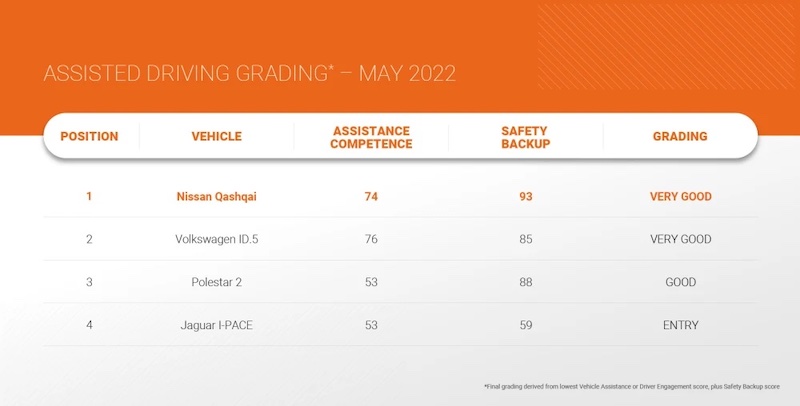Latest Euro NCAP gradings show Nissan and Volkswagen are ‘bringing high-performance assisted driving to the mainstream’
The latest round of Euro NCAP results feature assessment of four new cars with “Level 2 Assisted Driving systems”.
The gradings are based on dedicated protocols designed to encourage the safe adoption of Assisted Driving technology.
The safest systems should provide a good balance of performance across three key areas: the technical competence of the system and level of assistance it can safely offer, the feedback given to the driver to ensure they remain engaged and aware of their responsibilities, and how the car’s safety back-up mechanisms function in the event of an emergency.
The Nissan Qashqai, the What Car? Safety Award winner for 2022, continues to pave the way for accessible safety, scoring 74 percent for assistance competence and 93 percent for safety back-up.
Its ProPilot system provides a good and balanced level of driver engagement and driving assistance, achieving a “very good” result overall.

The system can adapt to speed limit changes and road features that require a change of speed such as curves in the road and upcoming roundabouts.
Additionally, the Autonomous Emergency Braking (AEB) system provides an excellent level of emergency support, avoiding most collisions with both moving and stationary vehicles.
Matthew Avery, chief research strategy officer, Thatcham Research, says: “The Nissan Qashqai continues its exceptional performance in Euro NCAP safety tests.
“Previously a ‘very good’ rating has been the preserve of premium vehicles, however Nissan has proven that it is possible to deliver a high performing, well-balanced assisted driving experience at the more affordable end of the market, proving that as technology develops it becomes more accessible and ultimately ubiquitous.”
The VW ID.5 was also rated in this group. Its Travel Assist system was rated “very good”, scoring 76% for assistance competence and 85 percent for safety back-up.
It scored full marks in assisting the driver in guiding the vehicle through motorway curves and for its steering interactivity when altering lane position.
The ID.5 performed very well in all areas, especially in terms of speed adaptation when approaching roundabouts, junctions, and corners.
Finally, the Polestar 2 and Jaguar I-Pace were also rated. The Polestar 2’s Pilot Assist is another well-balanced system receiving a “good” rating, in part due to improvements made via an Over-the-Air update since the vehicle was rated in 2021.
This allows connected vehicles to receive important updates automatically, making sure that the consumer is always driving the safest version of the manufacturer’s car.
Assessments also revealed that the Polestar 2 successfully balances driver steering input with lane guidance to promote co-operative driving and mitigate against driver over-reliance.
However, the system is limited in other areas such as not being able to adapt speed for road features and its AEB system not responding as effectively to stationary cars.
In comparison, the Jaguar I-Pace achieved an “entry” level score. Although the driver engagement score was very good, meaning the system and brand marketing does not encourage over-reliance, it delivers a balanced assisted driving experience but lacks more advanced features.
The I-Pace is the only vehicle to feature in this round of testing that does not cease driving while the assisted driving mode is engaged if the driver becomes unresponsive.
Instead, the vehicle simply withdraws steering support but maintains the Adaptive Cruise Control function, as opposed to guiding the vehicle to a controlled stop.
Avery adds: “Some of the vehicles have performed very well in this latest round of testing, and it’s especially positive to add two new “very good” cars to the previous ratings.
“It is interesting to see the improvements Polestar has made to its vehicle using OTA updates, an excellent means of tweaking performance for the better overnight. It is also becoming ever more apparent that electrification and automation go hand in hand.
“We would strongly encourage drivers to use this technology, it is more than just a feature count, it protects drivers and other road users alike with numerous safety benefits, with the best systems automatically adapting to speed limits and traffic, keeping drivers in lane, and protecting your blind spots.”

